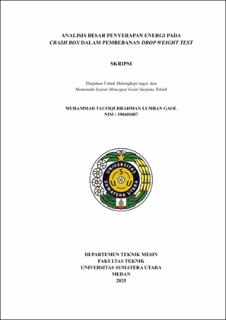Analisis Besar Penyerapan Energi pada Crash Box dalam Pembebanan Drop Weight Test
Analysis of Energy Absorption in Crash Box in Drop Weight Test Loading

Date
2025Author
Gaol, Muhammad Taufiqurrahman Lumban
Advisor(s)
Sabri, M
Metadata
Show full item recordAbstract
This research aims to analyze the amount of energy absorption in the crash box under drop weight test loading through numerical simulations based on the finite element method. A crash box is a passive safety component in a vehicle that is designed to absorb collision energy to reduce the impact of damage. This study used variations in crash box wall thickness (1 mm, 1.5 mm, and 2 mm) and height of the falling load (1 m, 2 m, and 3 m). The simulation data involves deformation parameters, reaction force and strain energy. Simulation results show that the thickness of the crash box and the height of the load significantly influence the amount of energy absorption. A crash box with a thickness of 2 mm at a load height of 3 meters has the highest energy absorption value of 1545.13 Joules. In addition, the highest crush force efficiency (CFE) was achieved by a crash box with a thickness of 2 mm at a height of 3 meters of 76%. Energy absorption increases with increasing crash box wall thickness and load height. It is hoped that this research can contribute to optimizing crash box design to improve the safety performance of four-wheeled vehicles. The results of this research also provide a reference for further research in the development of vehicle safety systems.
Collections
- Undergraduate Theses [975]
